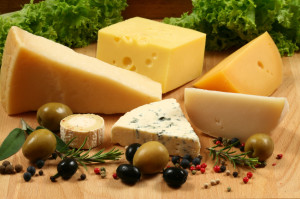 Curious epicureans, like me, love entertaining and exploring the simple elegance of food culture. And nothing is more straightforward yet chic than a savory cheese board to graze on at gatherings, both intimate and large. But there is more to it than just unwrapping your favorite fromage and slapping it on a plate. I turned to the pros at Food Network to learn how to put together the perfect platter.
Curious epicureans, like me, love entertaining and exploring the simple elegance of food culture. And nothing is more straightforward yet chic than a savory cheese board to graze on at gatherings, both intimate and large. But there is more to it than just unwrapping your favorite fromage and slapping it on a plate. I turned to the pros at Food Network to learn how to put together the perfect platter.
The first order of business is deciding exactly how much cheese you’ll need to procure. According to the Food Network, the rule of thumb bends depending on how you’re serving it. If you’re serving the cheese as a hors d’oeuvre, plan on 1 to 2 ounces of each cheese per person. If you’re serving the cheese as an after-dinner cheese course, figure 1 to 1 1/2 ounces of each cheese per person.
Once you have a quantity in mind, selecting the most delectable bites is the fun part. “Often one really great cheese is enough because it’s so satisfying that it becomes a conversation piece,” Food Network advises. “The exception is when cheese is the centerpiece of your party. In that case, you’ll need at least three and probably five or six cheeses. Most of the time, though, serving three cheeses is a good amount. That way you won’t overwhelm people with too many choices.”
If you’re serving cheese before dinner, choose lighter cheeses such as an herb-coated goat cheese or fresh mozzarella. If the cheese tray is coming out to tempt guests after dinner, then you can go one of two ways — “serve just one rich and creamy cheese such as the easy-to-find triple-crème cheese called St. Andre — or go for full-flavored cheeses like Manchego, cheddar, aged gouda and/or blue cheeses.”
Creating a themed cheese plate is an interesting way to assemble a nice variety. By region is another fun way to make choosing easier and encourage conversation, “These are both from such-and-such region of France,” you might explain. Or make it a family affair and select different types within the same family, for example “three or four styles of soft-ripened cheeses such as Brie and Camembert and any other cheeses that have a similar white downy-like rind. Or, you can select a few distinct styles of blue cheese. Doing this is a great way to learn how similar cheeses differ in flavor.” Team up contrasting textures for another option: “Go for a soft and creamy cheese such as Brie (or a similar artisan-style cheese made in your area); a firmer style cheese such as cheddar (preferably farmhouse), gouda or Gruyère; and a hard grating-style cheese like Parmigiano-Reggiano.”
Plating your selections can be simple too. Pro tip? It turns out, like a red wine, cheese ought to be served at room temperature, so your very first step will be to take the cheeses out of the fridge at least one hour ahead of party time. Don’t crowd the platter by arranging cheeses too closely. Provide a different knife with each cheese, to avoid muddying the flavors between them. Serve slices of a simple French baguette or more neutral crackers on the side, avoid herbs and flavors like garlic that will distract from the cheeses. “The exception is breads containing walnuts, dried fruit or olives,” the experts promise. “Serve before-dinner cheeses with relatively savory accompaniments such as olives, prosciutto, nuts and/or chutney and after-dinner cheeses with sweet accompaniments such as jams, honey, dried fruit and toasted nuts.” How do you put together a pleasing cheese appetizer or after dinner treat? — Casandra Armour

















